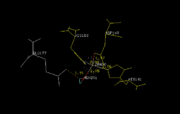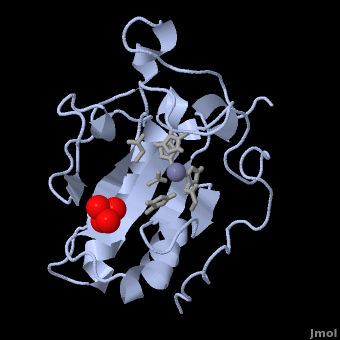Introduction
Sonic hedgehog (Shh) is a member of the Hedgehog (Hh) family of secreted extracellular signaling proteins, which serve important roles in regulating both short-range and long-range patterning processes in developing invertebrate and vertebrate tissues[1]. First discovered in Drosophila, where mutations of the single Hedgehog gene produces larvae that are covered in hedgehog-like denticles, Hh proteins are encoded by at least three genes in mammals - Sonic, Desert, and Indian hedgehog[2]. With the ability to control such fundamental processes as the anterioposterior patterning of vertebrate limb buds[3], the formation of motor neurons in the neural tube [4], and the development and maintenance of tissues and organs[5], Shh is the most well-studied member of the Hh signaling proteins[6]. Excessive signaling in adult cells has been implicated in the development of several human cancers[7][8]. Mutations in the Shh gene can also result in severe developmental consequences, including holoprosencephaly [9].
See also Hedgehog signaling pathway.
Biosynthesis
As with all members of the Hh family, Shh biosynthesis begins with an unusual molecular processing event. Following cleavage of its signal peptide, the Shh precursor protein is autocatalytically cleaved into two functionally distinct domains, a 19-kDa amino-terminal domain (Shh-N) and a 27-kDa carboxy-terminal domain (Shh-C)[10]. Spanning residues 24 to 197 in human Shh, Shh-N is responsible for all of the local and long-range signaling activities of Shh. Shh-C possesses an intramolecular transferase activity responsible for covalent attachment of a molecule of cholesterol to the C-terminus of Shh-N [6]. The addition of cholesterol serves to tether Shh-N to the cell membrane, restricting its range of activity to that of local signaling only[11]. A second modification involving the attachment of a palmitoyl group to Cys-24 on the protein's N-terminus has recently been discovered in insect and mammalian cells. This N-terminal modification is thought to increase the potency of the Shh-N signal as much as 30-fold[12].
Structural Overview

Figure 1. A close-up of the zinc coordination site of Shh-N, showing His 141, Asp 148, and His 183 separated by distances of 2.06, 1.97, and 2.08 Å, respectively. The zinc-bound water molecule is also shown in line with Glu 177, which is thought to participate in hydrolysis by abstracting a proton from the water molecule
[13].
The three-dimensional structure of murine Shh-N (residues 39-195) is shown as 1VHH. An α + β sandwich consisting of two and a six-stranded, mixed makes up the core of the structure, along with a two-stranded, antiparallel β-sheet
[13]. Although this type of folding arrangement has not yet been seen in other proteins, the presence of a in Shh-N bears close structural resemblance to the zinc coordination sites of zinc hydrolases, including thermolysin and carboxypeptidase A. Three amino acid side chains – – are bound to the zinc ion in the crystal structure, along with a single (Figure 1). Zinc ions that serve a structural role in proteins are normally coordinated by four amino acid side chains and are not usually exposed to the surrounding solvent. The presence of a zinc-bound water molecule in Shh-N, by contrast, is indicative of a catalytic function. In zinc hydrolases, the water molecule is key to the protein's enzymatic activity when its proton is removed by a nearby glutamate residue. (Figure 1) likely serves the same role in Shh-N, further supporting a novel, hydrolytic function for this protein. Based on the catalytic mechanisms for thermolysin and carboxypeptidase A, three non-coordinating residues in Shh-N () are also believed to participate in a potential hydrolysis reaction
[13].
The crystal structure of Shh-N also contains a single sulphate molecule, shown in red and yellow, which interacts with arginine residues at the interface of two Shh-N molecules. Since Shh-N binds heparin, this interaction is believed to comprise a heparin-binding region[13].
Function
![Figure 2. Shh-N is released from the cell membrane for long-range signaling by zinc-dependent proteolysis. [Note: This figure is adapted from references and .]](/wiki/images/thumb/4/46/Short_and_Long-Range.jpg/180px-Short_and_Long-Range.jpg)
Figure 2. Shh-N is released from the cell membrane for long-range signaling by zinc-dependent proteolysis. [Note: This figure is adapted from references
[13] and
[14].]
The tetrahedrally coordinated zinc ion of Shh-N, along with the non-coordinating residues thought to assist hydrolysis, are highly conserved among vertebrate Hh proteins. A potential hydrolytic activity is therefore expected to play an important cellular role. In pursuit of a substrate for Shh-N, it was found that near the C-terminus of one Shh-N molecule can hydrogen bond with residues in the zinc binding site of a second Shh-N molecule. This indicates that the protein may be capable of cleaving between Lys 195 and Ser 196 within its own C-terminus
[13]. This is the most highly conserved region of Hh proteins
[14]. The suspected autoproteolytic function of Shh-N has been suggested to liberate the tethered protein from the cell membrane to facilitate long-range signaling (Figure 2)
[13]. However, other possible substrates for Shh-N are also likely, including an Shh receptor or other types of signaling molecules involved in the Shh pathway. Whichever the substrate, the discovery of a potential proteolytic activity for Shh-N seems to provide a mechanism for regulating short-range and long-range signaling, which until now has been poorly understood
[6]. Short-range signaling occurs in a contact-dependent fashion and is associated with induction of the
floor plate within the neural tube
[15]. During long-range signaling, Shh-N acts as a morphogen to establish somite patterning
[10], motor neuron formation in the neural tube
[4], and anteroposterior limb patterning
[3].
Sonic Signaling: The Shh-Gli Pathway
![Figure 3. The Sonic hedgehog signaling pathway. In the absence of Shh, Patched inhibits Smo. Inhibition of Patched by Shh activates normal developmental processes. [Note: This figure is adapted from references and .]](/wiki/images/thumb/8/85/SHH_SIGNALING_PATHWAY.jpg/180px-SHH_SIGNALING_PATHWAY.jpg)
Figure 3. The Sonic hedgehog signaling pathway. In the absence of Shh, Patched inhibits Smo. Inhibition of Patched by Shh activates normal developmental processes. [Note: This figure is adapted from references
[8] and
[16].]
In the absence of a Shh signal, a 12 transmembrane receptor protein called Patched blocks the function of Smoothened (Smo), a seven-pass transmembrane protein, by keeping it sequestered in an intracellular vesicle (Figure 3)[16]. When Shh binds to Patched, inhibition of Smo by Patched is relieved. Patched becomes endocytosed, and Smo translocates to the cell surface. In vertebrates, Smo localizes to the surface of the primary cilium, initiating a signaling cascade that leads to the activation of Gli transcription factors [8]. Present in both the nucleus and cytoplasm, there are three of these regulatory proteins (Gli1, Gli2, and Gli3). Following Shh signaling, all three proteins can act as transcriptional activators of Shh target genes. Gli3, however, can act as both an activator and repressor; in the absence of Shh signaling, Gli3 is cleaved by the proteasome, and its truncated form accumulates in the nucleus where it represses transcription of Shh-responsive genes (Figure 3) [16].
3D Structures of sonic hedgehog
Sonic hedgehog 3D structures
Additional Resources
For additional information, See: Cancer


![Figure 2. Shh-N is released from the cell membrane for long-range signaling by zinc-dependent proteolysis. [Note: This figure is adapted from references and .]](/wiki/images/thumb/4/46/Short_and_Long-Range.jpg/180px-Short_and_Long-Range.jpg)
![Figure 3. The Sonic hedgehog signaling pathway. In the absence of Shh, Patched inhibits Smo. Inhibition of Patched by Shh activates normal developmental processes. [Note: This figure is adapted from references and .]](/wiki/images/thumb/8/85/SHH_SIGNALING_PATHWAY.jpg/180px-SHH_SIGNALING_PATHWAY.jpg)
